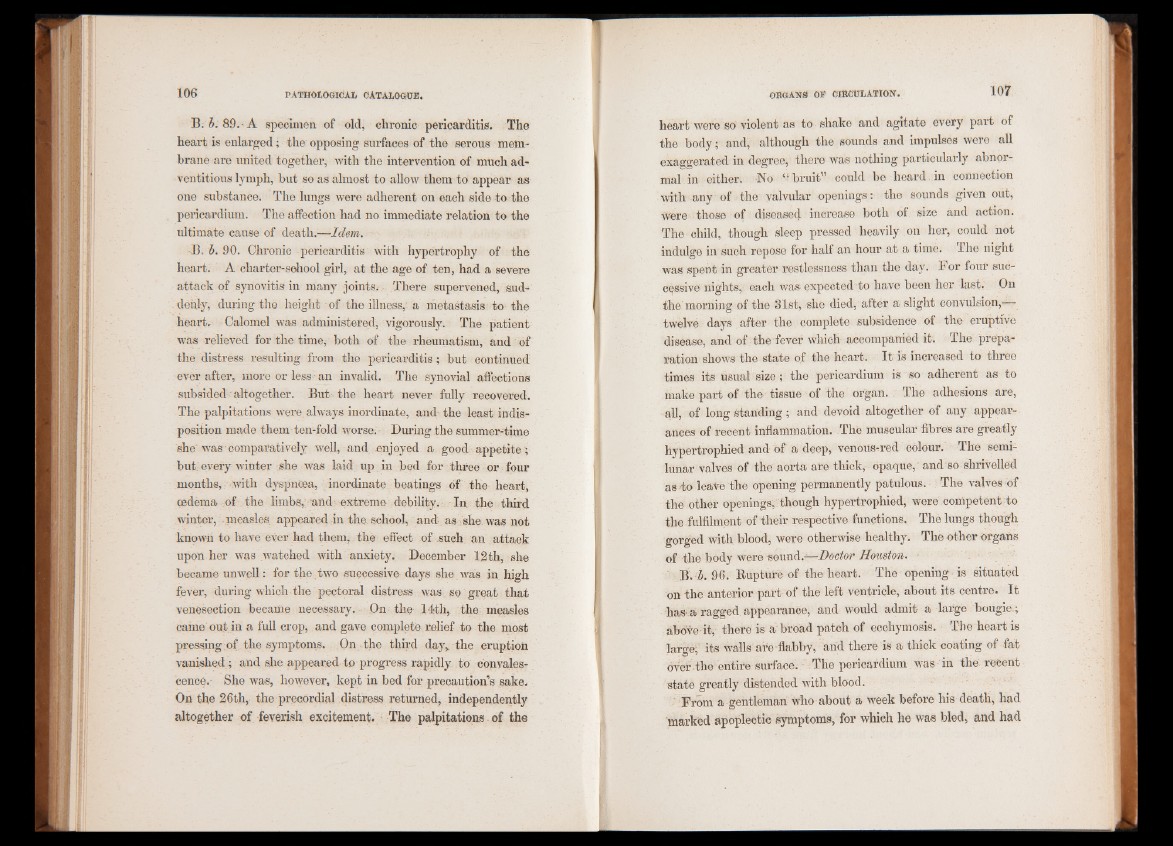
B. b. 89. A specimen of old, chronic pericarditis. The
heart is enlarged; the opposing surfaces of the serous membrane
are united together, with the intervention of much adventitious
lymph, but so as almost to allow them to appear as
one substance. The lungs were adherent on each side to the
pericardium. The affection had no immediate relation to the
ultimate cause of death.—Idem.
B. b. 90. Chronic pericarditis with hypertrophy of the
heart. A charter-school girl, at the age of ten, had a severe
attack of synovitis in many joints. There supervened, suddenly,
during the height of the illness,1 a metastasis to the
heart. Calomel was administered, vigorously. The patient
was relieved for the time, both of the rheumatism, and of
the distress resulting from the pericarditis; but continued
ever after, more or less- an invalid. The synovial affections
subsided altogether. But the heart never fully recovered.
The palpitations were always inordinate, and the least indisposition
made them ten-fold worse. During the summer-time
she'was comparatively well, and enjoyed a good appetite;
but; every winter she was laid up in bed for three or - four
months, with dyspnoea, inordinate beatings of the heart,
oedema of the limbs, and extreme debility. In the third
winter, measles, appeared in the. sebool, and as she was not
known to have ever had them, the effect of such an attack
upon her was watched with anxiety. December 12th, she
became unwell: for the two successive- days she was in high
fever, during which the pectoral distress was. so great that
venesection became necessary. On the 14th, the measles
came out in a full crop, and gave complete relief to the most
pressing of the symptoms. On the third day, the eruption
vanished.; and she appeared to progress rapidly to convalescence.
She was, however, kept in bed for precaution’s sake.
On the 26th, the precordial distress returned, independently
altogether of feverish excitement. The palpitations of the
heart were so violent as to shake and agitate every part of
the body ; and, although the sounds and impulses were all
exaggerated in degree, there was nothing particularly abnormal
in either. -No “ bruit” could be heard in connection
with any of the valvular openings : the sounds given out,
were those of diseased increase both of size and action.
The child, though sleep pressed heavily on her, could not
indulge in such repose for half an hour at a time. The night
was spent in greater restlessness than the day. For four successive
nights, each was expected to have been her last? On
the morning of the 31st, she died, after a slight convulsion,
twelve days after the complète subsidence of the eruptive
disease, and of the fever which accompanied it. The preparation
shows the state of the heart. It is increased to three
times its usual size ; the pericardium is so adherent as to
make part of the tissue of the organ. The adhesions are,
all, of long standing; and devoid altogether of any appearances
of recent inflammation. The muscular fibre's are greatly
hypertrophied and of a deep, venoüs-red colour. The semilunar
valves of the aorta ate thick, opaque, ’ and so shrivelled
as-to leave the opening permanently patulous. The valves of
the other openings, though hypertrophied, were competent to
the fulfilment of their respective functions. The lungs though
gorged with blood, were otherwise healthy. The other organs
of the body were -sound.—Doctor Houston. ■
B. i. 96. Rupture of the heart. The opening is situated
on the anterior part of the left ventricle, about its centre. It
has-a> ragged appearance, and would admit a large bougie.;
above-it, there is a broad patch of ecchymosis. The heart is
large; its Walls are-flabby, and there is a thick coating of fat
over-the entire surface. • The pericardium was in the recent
state greatly distended with blood.
From a gentleman who about a week before his death, had
marked apoplectic symptoms, for which he was bled, and had